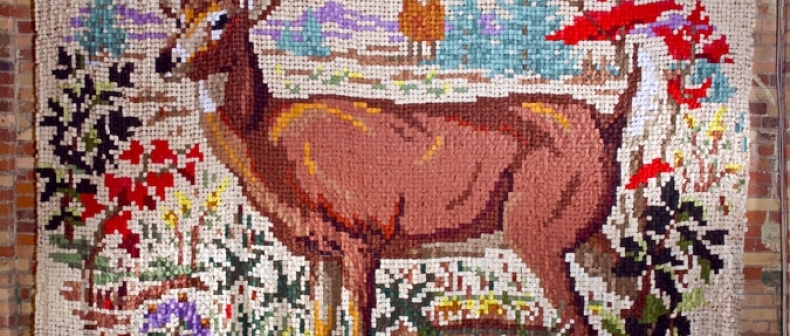
Grant Heaps’ Stag (2012)
Nationalistic survey shows are a problem in this country, and definitely in this city. No matter how they’re done, there is inevitably a chorus of griping, some of it legitimate (how many women? how many native artists? how much diversity of media?) and some of it nitpicky poppycock (why this one and not that one?). Every survey show of a nationalist order actually mounted ourselves involves a procession of fretting so epic, it’s almost like a ritual cleansing before the preparation of a meal — and most of the time the meal doesn’t even get served. And every survey show done by an outsider involves raised eyebrows so severe, it’s a wonder our collective foreheads aren’t sprained. Just witness the critical reception to MASS MOCA’s Oh Canada: so much excited buzz leading up to the opening, followed by a directly proportional amount of whining once people had actually seen the damned thing.
It’s some kind of minor miracle, then, that the Textile Museum of Canada’s newest show, Dreamland: Textiles and the Canadian Landscape, is not only such a success, but such a refreshingly graceful one. The work hangs together seamlessly, and the didactics — precise, engaged, clear — illuminate rather than wasting time with condescending hype-laced jargon. Curators Shauna McCabe, Natalia Nekrassova, Sarah Quinton and Roxane Shaughnessy mine the permanent collection of the Textile Museum, and mix and match their holdings of quilts, blankets, hook-rugs and handmade clothing with pieces by contemporary Canadian artists. This effortless-seeming combination produces a clear, broad-ranging picture of Canadiana. The works cover the country from coast-to-coast, from its settler days to now, and are certainly not free of troublesome political implication. But not only is the latter acknowledged, the didactic material actually raises the meatiest point in the whole show: that such political troubles are woven into the warp and weft of Canadian history.
The central narrative of the show seems to be survival — or to be more specific, how necessity is the mother of invention and the grandmother of ornamentation. Most of the archival material is rugs and blankets; we begin with utilitarian things, objects crafted by early settlers and farmers to make the most of meagre means and keep the wolf (and the bitter cold) from the door. These various coverings were initially made from scraps: rags and worn sweaters efficiently repurposed. This haphazard construction created patchwork patterns, and as the show wears on, and industrialism introduces things like electrical heating, the (largely) women who craft these blankets become more adept at exploiting pattern, refining technique, and turning a survival skill into an astoundingly dexterous craft.
As patterns are introduced, so too are images: where the ornamentation of a rug was once determined by the kinds of fabric scraps that were available, soon these hook rugs became a means for (largely) rural folk to tell their stories: fishing, hunting, plowing; the dream of life in the new world, the slow narrative of the emergence of civilization on a new frontier. The climax of this textile narrative is the Hudson’s Bay Blanket, and the curators, who thus far have attentively let every inch of cloth speak for itself, allow the wool blanket to tell its own vastly complex tale: of discovery, industry, mechanization, efficiency; and exploitation, colonization, murder.
The contemporary artwork augments the narrative by providing tangential commentary. In Amelie Atkins’ Embrace, twin Ukranian sisters meet and embrace on a prairie road after a series of false starts and missed marks, to a clumsy piano version of Edelweiss. The video is a paean to immigration and the idea of home that, in its sweetness, misses none of either concept’s complexities. John Henry Fine Day’s stuffed animals (a rabbit and a dog), made of sinew and hide, seem like eerily cuddly familiars. Michael Snow’s hour-long Solar Breath (Northern Caryatids) documents the movement of curtains against a window in his Newfoundland cottage. The drapes begin to anthropomorphize: one billows and shudders, neurotically plastering itself against the window, seemingly wanting to free itself into the wind; the other wafts calmy and gently. Grant Heaps’ epic Stag, a wall-sized fabric mosaic of the titular animal, neatly echoes the wildlife narratives of the hook-rugs and Haida mats that surround it. And Graeme Patterson’s stop-motion Monkey and Deer — a loose fable set in the isolated dark of Woodrow, Saskatchewan — captures a kind of distinctly Canadian weirdness.
Ultimately, the show’s resounding success lies with the materials themselves. This is absolutely not to discount the significant curatorial efforts that went into arranging it. The curators have an eminent luxury that’s particular to the way the Textile Museum works; they are able to deal with primary sources. They include artist’s commentary, but they are always cognizant of how loudly and eloquently these two-hundred-year-old textiles can speak. There is a beautiful harmony achieved in Dreamland, where, across centuries and cities and the whole breadth of a landmass, two modes of artmaking enrich and deepen each other’s songs.
Dreamland: Textiles and the Canadian Landscape continues at the Textile Museum of Canada until September 30.
______
Sholem Krishtalka is the Toronto Standard’s art critic.
For more, follow us on Twitter @TorontoStandard and subscribe to our newsletter.














